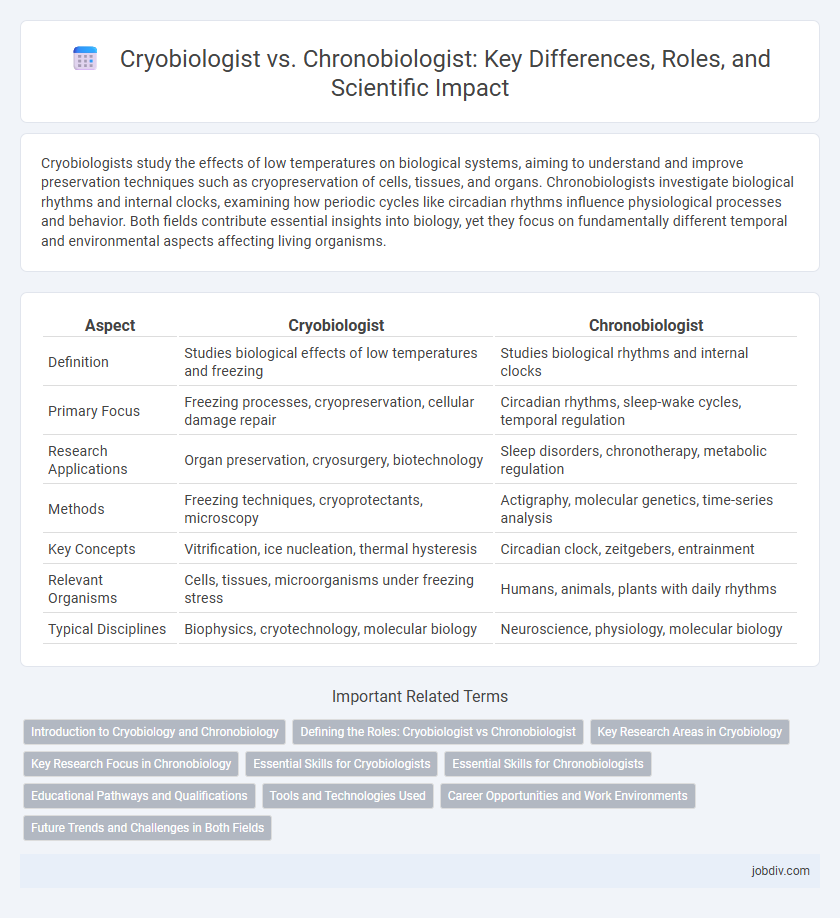Cryobiologists study the effects of low temperatures on biological systems, aiming to understand and improve preservation techniques such as cryopreservation of cells, tissues, and organs. Chronobiologists investigate biological rhythms and internal clocks, examining how periodic cycles like circadian rhythms influence physiological processes and behavior. Both fields contribute essential insights into biology, yet they focus on fundamentally different temporal and environmental aspects affecting living organisms.
Table of Comparison
| Aspect | Cryobiologist | Chronobiologist |
|---|---|---|
| Definition | Studies biological effects of low temperatures and freezing | Studies biological rhythms and internal clocks |
| Primary Focus | Freezing processes, cryopreservation, cellular damage repair | Circadian rhythms, sleep-wake cycles, temporal regulation |
| Research Applications | Organ preservation, cryosurgery, biotechnology | Sleep disorders, chronotherapy, metabolic regulation |
| Methods | Freezing techniques, cryoprotectants, microscopy | Actigraphy, molecular genetics, time-series analysis |
| Key Concepts | Vitrification, ice nucleation, thermal hysteresis | Circadian clock, zeitgebers, entrainment |
| Relevant Organisms | Cells, tissues, microorganisms under freezing stress | Humans, animals, plants with daily rhythms |
| Typical Disciplines | Biophysics, cryotechnology, molecular biology | Neuroscience, physiology, molecular biology |
Introduction to Cryobiology and Chronobiology
Cryobiology examines the effects of low temperatures on living organisms, focusing on cellular preservation, cryopreservation techniques, and the biological implications of freezing and thawing processes. Chronobiology studies biological rhythms and timing, investigating circadian, ultradian, and infradian cycles that regulate physiological and behavioral patterns in organisms. Both fields integrate molecular biology and physiology to advance understanding of life processes under temporal and environmental influences.
Defining the Roles: Cryobiologist vs Chronobiologist
Cryobiologists specialize in studying the effects of low temperatures on biological systems, focusing on the preservation of cells, tissues, and organs through cryopreservation techniques. Chronobiologists examine the biological rhythms and internal clocks that govern physiological processes, including circadian, ultradian, and infradian cycles. Both disciplines contribute to understanding life sciences but target fundamentally different temporal and environmental conditions affecting living organisms.
Key Research Areas in Cryobiology
Cryobiology primarily investigates the preservation of biological materials at low temperatures, focusing on cryopreservation, vitrification, and freeze tolerance mechanisms in cells and tissues. Research also explores the effects of freezing and thawing on cellular integrity and metabolic processes, contributing to advancements in organ transplantation and reproductive technology. Key studies include cryoprotectant toxicity, ice crystallization control, and molecular adaptations enabling survival in extreme cold environments.
Key Research Focus in Chronobiology
Chronobiologists primarily investigate the mechanisms and effects of biological rhythms, including circadian, ultradian, and infradian cycles, on physiological processes and behavior in organisms. Their research focuses on understanding how environmental cues like light and temperature synchronize internal clocks to optimize health, sleep patterns, hormone release, and metabolic functions. This field plays a crucial role in developing treatments for sleep disorders, jet lag, and chronotherapy for diseases influenced by biological timing.
Essential Skills for Cryobiologists
Cryobiologists require a strong foundation in cryopreservation techniques, molecular biology, and thermodynamics to understand cellular responses at ultra-low temperatures. Expertise in microscopy and biochemical assays is essential to analyze cryoinjury mechanisms and optimize freezing protocols. Proficiency in data analysis and experimental design supports advancements in tissue preservation and regenerative medicine.
Essential Skills for Chronobiologists
Chronobiologists require a strong foundation in molecular biology, neuroscience, and data analysis to study biological rhythms effectively. Proficiency in statistical modeling and experience with chronobiological research tools like actigraphy and polysomnography enhance their ability to interpret circadian patterns. Expertise in experimental design and familiarity with genetic and environmental factors influencing biological clocks are essential for advancing chronobiological science.
Educational Pathways and Qualifications
A Cryobiologist typically pursues a degree in biology, biochemistry, or biomedical sciences, often followed by specialized graduate studies in cryopreservation or low-temperature biology. Chronobiologists usually obtain degrees in biology, physiology, or neuroscience, with advanced training focused on circadian rhythms, molecular biology, and behavioral science. Both fields demand strong research skills, but cryobiology emphasizes expertise in cryogenic techniques while chronobiology requires in-depth knowledge of temporal biological processes.
Tools and Technologies Used
Cryobiologists employ advanced cryopreservation equipment such as controlled-rate freezers, vitrification tools, and ultra-low temperature storage systems to study the effects of low temperatures on biological specimens. Chronobiologists utilize actigraphy devices, chronometers, and molecular biology tools like PCR and gene expression assays to analyze biological rhythms and circadian cycles. Both fields integrate innovative imaging technologies and computational modeling software to enhance data accuracy and experimental outcomes.
Career Opportunities and Work Environments
Cryobiologists specialize in studying the effects of low temperatures on biological systems, leading to career opportunities in medical research, cryopreservation, and biotechnology industries focused on organ and tissue preservation. Chronobiologists investigate biological rhythms and internal clocks, often working in academic institutions, pharmaceuticals, and healthcare settings to develop treatments based on circadian biology. Both fields offer interdisciplinary work environments that include laboratories, clinical research centers, and technology-driven companies aiming to innovate in health sciences and biological time management.
Future Trends and Challenges in Both Fields
Cryobiologists are advancing cryopreservation techniques to enhance organ transplantation viability and long-term biobanking, while addressing challenges such as ice crystal formation and cellular damage during freezing. Chronobiologists are increasingly leveraging genomic and wearable technology data to better understand circadian rhythm disruptions linked to chronic diseases, aiming to develop personalized chronotherapeutic interventions. Both fields face the future challenge of integrating multidisciplinary approaches and artificial intelligence to optimize biological timing and preservation outcomes.
Cryobiologist vs Chronobiologist Infographic

 jobdiv.com
jobdiv.com